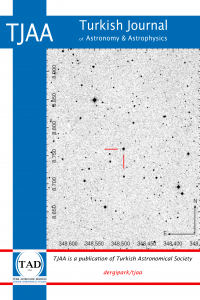Doğu Anadolu Gözlemevine (DAG) Yönelik İlk Kozmik Işın Dedektörünün Kurulması ve Test Ölçümleri
Bu çalışmada, Atatürk Üniversitesi Astronomi ve Uzay Bilimleri Bölümü ile Astrofizik Araştırma ve Uygulama Merkezi (ATASAM) bünyesinde ortak tasarlanan kozmik ışın (müon) dedektörünün kurulum aşamaları ve ilk sonuçları sunulmaktadır. Bu kapsamda ilk ölçümler, 21- 30 Mayıs 2022 tarihleri arasında Erzurum Atatürk Üniversitesi yerleşkesinde bulunan ATA50 Teleskobu yakınında yapılmıştır. Dedektör sintilatörleri, Zenite bakacak şekilde (0°) yerleştirilmiştir. Alınan veriler, Python ve ROOT programları ile analiz edilmiştir. Bu sayede, ilk veriler 1885 metre rakıma sahip Atatürk Üniversitesi yerleşkesinin kozmik müon akısı olarak elde edilmiştir. Bölgenin akı değeri, literatürden alınan farklı irtifalardaki akı değerleri ile karşılaştırılmıştır. Böylece, Doğu Anadolu Gözlemevi (DAG) için sürekli kozmik ışın ölçümleri yapacak bir istasyon kurulumunun ilk çalışmaları tamamlanmıştır.
Anahtar Kelimeler:
Cosmic Rays, Muon, Flux, DRS4, Scintillation, Time of Flight
Setup and Test Measurements of the First Cosmic Ray Detector for the Eastern Anatolian Observatory (DAG)
Measurement of the cosmic rays are one of the most studied topics in recent years. In this study, the installation stages of the cosmic muon measurement detector was established and developed within the Atatürk University Department of Astronomy and Space Sciences and the Astrophysics Research and Application Center (ATASAM), and the first measurement results are presented. The measurements were obtained between 21-30 May 2022 by taking data from the ATA50 building in Erzurum Atatürk University Campus. The detectors' scintillator plates are placed perpendicular to the zenith. The received data were analyzed with Python and ROOT programs. The results are shown on the histogram and figures. Moreover, cosmic muon flux of the Atatürk University campus at an altitude of 1885 meters is obtained. The flux value of the region was compared with the flux values at different altitudes taken from the literature. Thus, the first studies of a station that will make continuous cosmic ray measurements for the Eastern Anatolia Observatory (DAG) have been completed.
Keywords:
Cosmic Rays, Muon, Flux, DRS4, Scintillation, Time of Flight,
___
- Ahmed S. N., 2007, Physics and Engineering of Radiation Detection, Academic Press
- Atakan M., 2014, Yüksek Lisans Tezi, Kafkas Üniversitesi Fen Bilimleri Enstitüsü, Yüksek Lisans Tezi
- CERN, 2022, https://home.cern/science/physics/cosmic-rays-particles-outer-space
- Gaisser T. K., Engel R., Resconi E., 2016, Cosmic Rays and Particle Physics
- Groom D., 2004, in Amico P., Beletic J. W., Belectic J. E., eds,
- Astrophysics and Space Science Library Vol. 300, Scientific Detectors for Astronomy, The Beginning of a New Era. pp 81–93, doi:10.1007/978-1-4020-2527-3_9
- Hamamatsu 2022, Fotosensör Module, https://www.hamamatsu.com/jp/en/product/optical-sensors/pmt/pmt-module/current-output-type/H10721-110.html
- Iori M., Sergi A., 2008, Nuclear Instruments and Methods in Physics Research A, 588, 151
- Moore, J., 2014, http://jcmooreonline.com/tag/normal-distributions/
- Radec 2022, DRS4 Evaluation Board, https://www.radec.ch/product-page/drs4-evaluation-board
- Shalomeo 2022, https://www.shalomeo.com/Scintillators/SP101-Plastic-Scintillators/product-379.html
- Yilmaz A., 2019, Acta Physica Polonica B, 50, 1437
- Yayın Aralığı: Yılda 2 Sayı
- Başlangıç: 2020
- Yayıncı: Türk Astronomi Derneği
